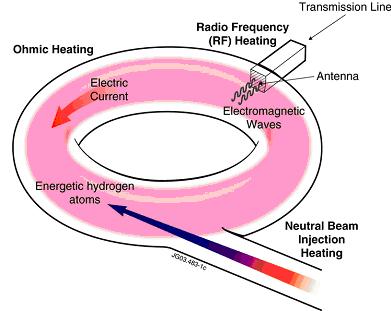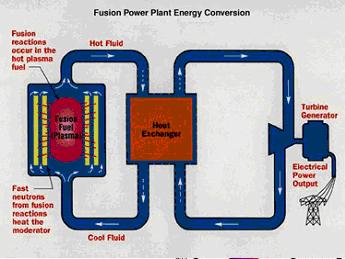In an operating fusion reactor, part of the energy generated will serve to maintain the plasma temperature as fresh deuterium and tritium are introduced. However, in the startup of a reactor, either initially or after a temporary shutdown, the plasma will have to be heated to the ignition temperature. There are a number of heating schemes:
· Ohmic Heating
Since the plasma is an electrical conductor, it is possible to heat the plasma by passing a current through it; in fact, the current that generates the poloidal field also heats the plasma. The heat generated depends on the resistance of the plasma and the current. But as the temperature of heated plasma rises, the resistance decreases and the ohmic heating becomes less effective. To reach the ignition temperature, additional heating methods is needed.
· Neutral-Beam Injection
Neutral-beam injection involves the introduction of high-energy (neutral) atoms into the ohmically -- heated, magnetically -- confined plasma. The atoms are immediately ionized and are trapped by the magnetic field. The high-energy ions then transfer part of their energy to the plasma particles in repeated collisions, thus increasing the plasma temperature.
· Radio-frequency Heating
In radio-frequency heating, high-frequency waves are generated by oscillators outside the torus. If the waves have a particular frequency (or wavelength), their energy can be transferred to the charged particles in the plasma, which in turn collide with other plasma particles, thus increasing the temperature of the bulk plasma.

Source: www.tpg.efda.org/hcd/index.htm
A fusion power plant would be like a conventional one, but heat energy coming from a fusion reactor running on fusion fuel (a deuterium-tritium (D-T) mixture).
The fuel, in the form of very high temperature plasma, is held away from the chamber walls by magnetic forces long enough for a useful number of reactions to take place. The generated energy is re-circulated within the plasma via collisions of the charged fusion products (helium nuclei) with the newly injected cold fuel atoms which are then ionized and heated to sustain the fusion reaction. The neutrons, having no charge, move in straight lines through the thin walls of the vacuum chamber with little loss of energy.
The neutrons and their 14 MeV of energy are absorbed in a "blanket" containing lithium which surrounds the fusion chamber. Through collisions with the lithium nuclei, the neutrons slow down and give up their kinetic energy to heat up the blanket. The heat is extracted through a cooling circuit and conveyed to a conventional steam electric plant. The neutrons themselves ultimately react with lithium to generate tritium which is separated and fed back into the reactor as a fuel.
Specific engineering requirements of a fusion power plant include use of materials resistant to energetic neutron bombardment, thermal stress, and magnetic forces, and design of exhaust systems for the removal of spent gas.

Source: http://www.pppl.gov/fusionpowerplant.cfm